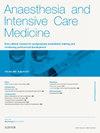Crystalloids, colloids, blood and blood products and substitutes
IF 0.3
Q4 ANESTHESIOLOGY
引用次数: 0
Abstract
Intravenous fluids are a core therapy in critical care and perioperative practice. Although most fluids that we use today are very similar to those of the mid 20th Century, our understanding of the physiology of the cardiovascular system, the microcirculation and the extravascular space has evolved considerably. In modern practice, thought should be given to the distribution of stressed and unstressed blood volume, the glycocalyx and the gelatinous interstitial matrix. All of these components change dynamically in volume depleted states.
In the dehydrated patient, if given slowly, most intravenous fluid remains in the circulation. However, if delivered rapidly, much of the it extravasates into the interstitium causing hydraulic damage and oedema.
In general, isotonic balanced crystalloid solutions should be used in preference to 0.9% saline for resuscitation, and hypotonic crystalloid solutions, containing generous quantities of potassium, should be used for maintenance. There is minimal indication for colloidal products in modern medicine, with the exception of human albumin solution in liver disease. Blood products are indicated as the primary resuscitation tool in haemorrhagic shock.
晶体、胶体、血液及血液制品及代用品
静脉输液是重症监护和围手术期的核心治疗方法。尽管我们今天使用的大多数液体与20世纪中期的液体非常相似,但我们对心血管系统、微循环和血管外空间的生理学的理解已经有了很大的发展。在现代实践中,应考虑应激和非应激血容量、糖萼和胶质间质基质的分布。所有这些组件在体积耗尽状态下动态变化。在脱水病人中,如果缓慢给药,大部分静脉液体仍留在循环中。然而,如果快速输送,大部分它会渗出到间质中,造成水力损伤和水肿。一般情况下,应优先使用等渗平衡晶体溶液而不是0.9%生理盐水进行复苏,并应使用含有大量钾的低渗晶体溶液进行维持。在现代医学中,除了人类白蛋白溶液治疗肝病外,胶体产品的适应症很少。血液制品被认为是失血性休克的主要复苏工具。
本文章由计算机程序翻译,如有差异,请以英文原文为准。
求助全文
约1分钟内获得全文
求助全文
来源期刊

Anaesthesia and Intensive Care Medicine
ANESTHESIOLOGY-
CiteScore
0.50
自引率
0.00%
发文量
152
期刊介绍:
Anaesthesia and Intensive Care Medicine, an invaluable source of up-to-date information, with the curriculum of both the Primary and Final FRCA examinations covered over a three-year cycle. Published monthly this ever-updating text book will be an invaluable source for both trainee and experienced anaesthetists. The enthusiastic editorial board, under the guidance of two eminent and experienced series editors, ensures Anaesthesia and Intensive Care Medicine covers all the key topics in a comprehensive and authoritative manner. Articles now include learning objectives and eash issue features MCQs, facilitating self-directed learning and enabling readers at all levels to test their knowledge. Each issue is divided between basic scientific and clinical sections. The basic science articles include anatomy, physiology, pharmacology, physics and clinical measurement, while the clinical sections cover anaesthetic agents and techniques, assessment and perioperative management. Further sections cover audit, trials, statistics, ethical and legal medicine, and the management of acute and chronic pain.
 求助内容:
求助内容: 应助结果提醒方式:
应助结果提醒方式:


